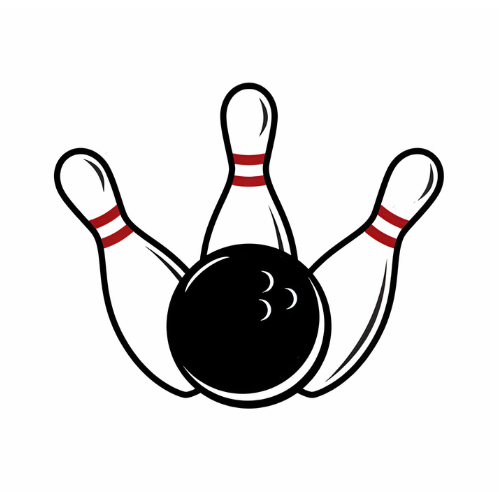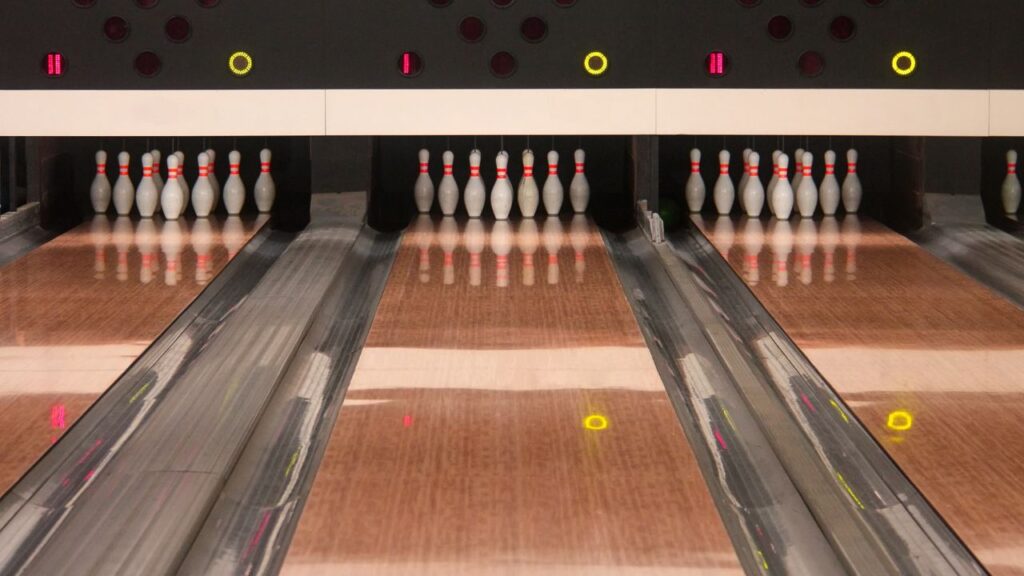A typical bowling alley lane is approximately 60 feet long. Bowling alley lanes are typically 60 feet in length. Bowling is a popular recreational sport enjoyed by people of all ages. The game involves rolling a bowling ball down a long, narrow lane with the goal of knocking down as many pins as possible. But have you ever wondered how long a bowling alley lane actually is?
Well, the answer is that a typical lane is approximately 60 feet long. This length is consistent across most bowling alleys, providing players with a standardized playing field. Whether you are a seasoned pro or a casual bowler, the length of the lane is an important factor to consider when aiming for that perfect strike. So, next time you step foot in a bowling alley, remember that the lane stretches out before you, measuring 60 feet in length.

Origins Of Bowling Alley Lanes
Bowling alley lanes have a long history that dates back centuries. The origins of these lanes can be traced back to the early days of bowling. Throughout history, bowling lanes have evolved and been shaped by pioneering designers and advancements in lane construction materials.
These advancements have led to the creation of more durable and consistent lanes. The length of a bowling alley lane can vary, but in most cases, it measures around 60 feet from the foul line to the pins. Several factors, including the size of the facility and the level of play, can influence the length of the lane.
Overall, the evolution of bowling alley lanes has greatly contributed to the growth and popularity of the sport.
Standard Dimensions: Unveiling The Surprising Facts
The length of a standard bowling alley lane may surprise you, as it is quite long compared to what you might expect. Variations in widths and lengths exist, but the official length is about 60 feet, or 18. 29 meters.
This length allows for the necessary space for players to bowl comfortably and for the pins to be set up at the end of the lane. Bowling alleys also need to consider additional space for players to wait their turn and for seating areas.
So, the next time you step into a bowling alley, take a moment to appreciate the impressive length of the lane, and let the games begin!
Decoding The Maintenance Procedures
Bowling alley lanes typically measure around 60 feet in length, from the foul line to the pins. The maintenance procedures for these lanes are crucial. Regular cleaning and oiling are essential to keep the lanes in optimal condition for bowlers.
Cleaning involves removing any dirt, debris, or oil buildup that can affect the ball’s performance and the bowler’s accuracy. Oiling, on the other hand, helps to enhance the ball’s roll and prevent excessive friction. Additionally, resurfacing is a necessary process to fix any wear and tear on the lanes.
Alley owners usually have a maintenance schedule in place to ensure that these procedures are regularly carried out. By following these maintenance procedures, bowling alleys can provide a consistent and enjoyable experience for bowlers of all skill levels.
The Role Of Lane Length In Scoring
A bowling alley lane typically measures around 60 feet in length, influencing scoring in various ways. Its length impacts bowling techniques, as professional bowlers employ specific strategies to navigate and conquer the lane. To maximize their performance, bowlers adapt their approaches, speeds, and angles based on the lane’s dimensions.
Grip, release, and spin techniques are also adjusted to achieve the desired ball trajectory and pin impact. Furthermore, the length of the lane affects the transition of oil patterns, adding an extra layer of complexity to the game. Professionals constantly analyze and readjust their game plans, keeping in mind the specific characteristics of each bowling alley lane.
With careful execution and mastery of technique, they strive to achieve optimal scores and outperform their competitors.
The Curiosity Behind Mini Bowling Alley Lanes
Mini bowling alley lanes have always piqued our curiosity due to their unique dimensions. Comparing them to standard-sized lanes provides interesting insights. Dimensions play a crucial role in determining the length of a bowling alley lane. Understanding these dimensions can help us appreciate the variation in mini bowling lanes.
It is fascinating to see how these smaller lanes still provide an enjoyable bowling experience despite their reduced size. The lengths of mini bowling alley lanes may differ from their standard counterparts, but they continue to offer excitement and skill-testing challenges.
Exploring these dimensions opens up a world of possibilities for enthusiasts who want to enjoy bowling on a smaller scale. From a gaming perspective, mini bowling alley lanes bring a whole new level of excitement and fun.
The Changing Definitions: Non-Standard Lanes
Bowling alleys come in various sizes, and standard lanes are typically 60 feet long. However, there are non-standard lanes recognized globally. These alternative lengths offer unique features and serve different purposes. They cater to different types of bowling games and challenge players with their varying lane lengths.
Internationally, there are recognized shorter and longer lanes, each providing a distinct experience. These alternative lanes ensure diversity in the sport and provide opportunities for bowlers to test their skills on different lane lengths. The recognition of non-standard lanes contributes to the growth and evolution of bowling, making it more engaging and captivating for enthusiasts worldwide.
Whether it’s a shorter lane or an extended one, bowlers can enjoy the excitement that comes with adapting to different lane lengths and strategies.
The Future Of Bowling Alley Lanes
The future of bowling alley lanes holds exciting innovations in lane technology, with predictions for new designs and dimensions. As technology advances, it is likely that bowling alley lanes will become more versatile and customizable to suit individual preferences. Innovations may include adjustable lane lengths, allowing bowlers to modify the distance to challenge their skills.
Furthermore, new lane materials and coatings may be developed to enhance performance and reduce maintenance. Additionally, lane designs could incorporate interactive elements, such as built-in sensors to provide real-time feedback on bowling techniques. These advancements aim to enhance the overall bowling experience, attracting both seasoned bowlers and newcomers to the sport.
With ongoing advancements, the future of bowling alley lanes looks promising, offering endless possibilities for innovation and excitement.
Conclusion
The length of a bowling alley lane plays a critical role in the game. The standard length of a lane is about 60 feet, but this can vary depending on the type of bowling alley. The size of a bowling alley lane is an important factor in determining the level of difficulty and accuracy required to achieve a successful bowl.
It provides great opportunities for players to challenge themselves and improve their skills, while also allowing for fun and friendly competition. The length of a bowling alley lane is carefully designed to create an enjoyable experience for bowlers of all skill levels.
Whether you are a professional bowler or a casual player, understanding the length of a bowling alley lane can enhance your appreciation for the game and help you strategize your approach. So next time you step onto a bowling alley, take a moment to appreciate the precise measurements and dimensions that contribute to the thrill and excitement of the sport.

